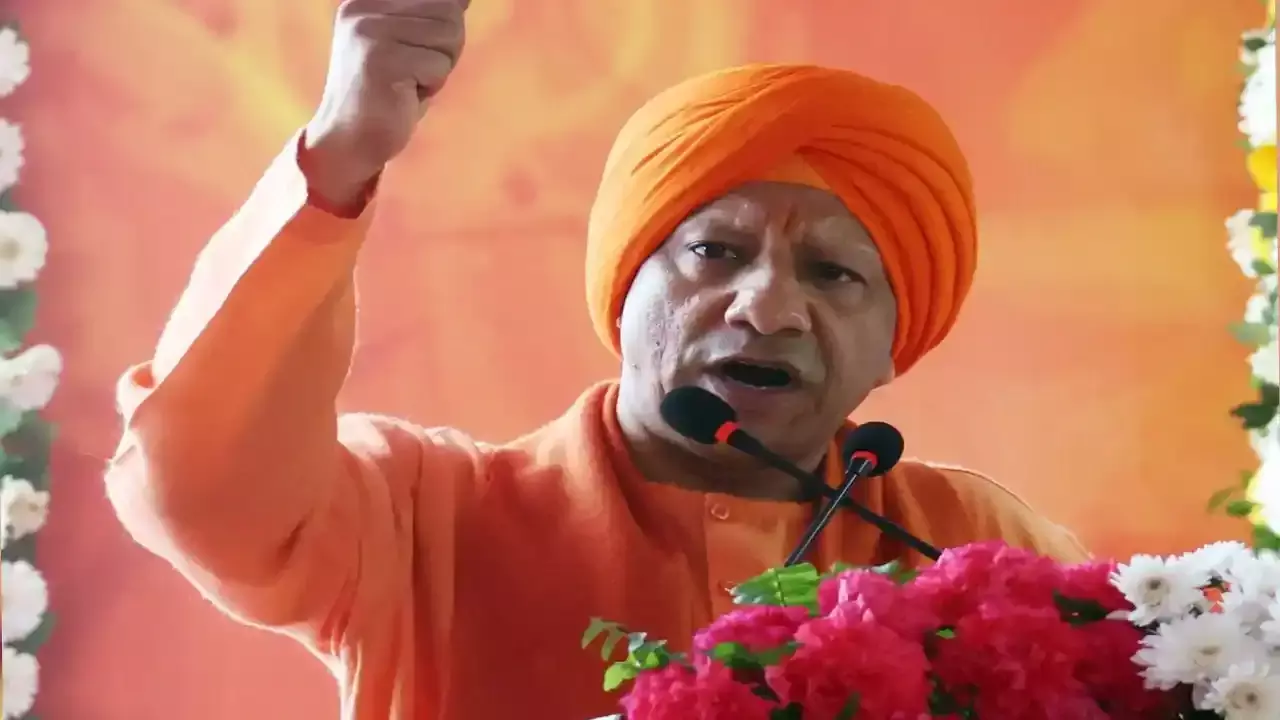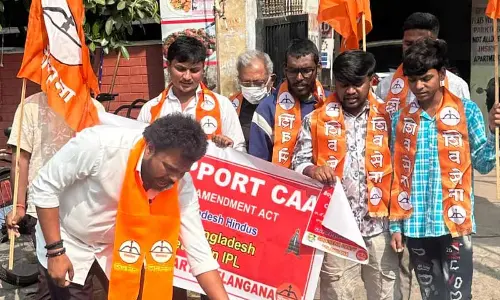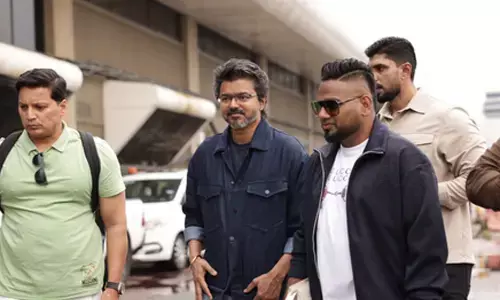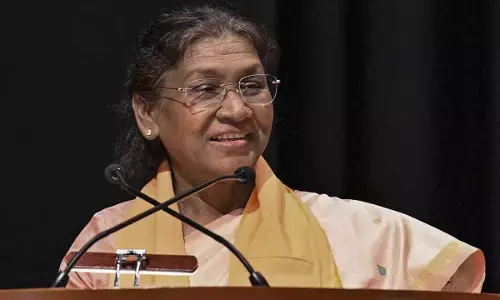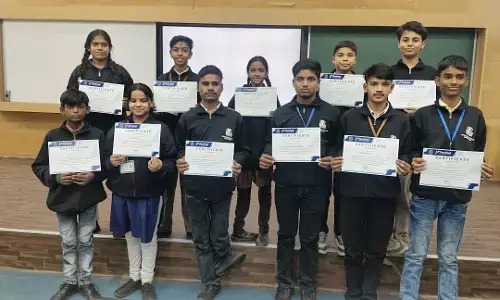Homage to Sri Sri

Homage to SRI SRI, On the Occasion of his Vardhanti on June 15. That matter to Sri Sri, (‘Mahaprastanam 1’) (1937) (The Great Odessey) consisting of 41 Sections, is hailed as the magnum opus of Sri Sri.
Homage to SRI SRI, On the Occasion of his Vardhanti on June 15.
.jpg)
SRI SRI
“I had my early education at Mrs. A.V.N. College, Visakhapatnam, where my father was a teacher of mathematics. The old man was not inclined towards the world of writing poems. But then, he had a penchant for words, and he inducted me into the world of rhythms of prosody. For higher education. I left for Madras and joined Madras Christian College, reputed for its high standards of teaching. In the 30’s which I call the hungry decade, I graduated in science. Once, I was taken ill with Typhoid and during the period of illness which lasted for over sixty three days, I underwent a sea change. In response to Rupert Brooke’s recipe for happiness, I found myself ‘reading poetry, writing poetry and living poetry’.
It was then that his magnumopus “Mahaprasthanam” came to be written. At that time, SRI SRI came under the influence of the rumblings of the Great October Revolution in Russia and the formation of the progressive writers Association in London. His poetic sensibility was roused and sharpened. He had moulded himself into a pioneer of the Marxist Idiom in Indian Poetry and with a rare courage of convictions and transparent sincerity, he proudly proclaimed himself;
“MAYAKOVESKY WAS DEAD
BUT I INHERITED HIS VISION”.
In his plastic years of youth, Sri Sri had flirted with wall painting. The world of worlds and the intensity of emotion it concealed within, surfaced to him, only later. Up to his sixth year, he used to give vent to the muralist in him. Referring to his irrepressible zeal in paining, he remarked “I became a menace to the white walls of my house”. But then, his father initiated him into ‘the euphonic aspect’ of Telugu and the muralist gracefully gave way to the poet in him. When he was barely 10 years old, he scripted the mythological play dealing with Savitri and Satyavan. The romantic exuberance of Devulapalli Krishna Sastry and the seductive spell of Viswanatha Satyanarayana had, of course, their impact on his early poetical outpourings. Very soon, he parted ways with them and got fascinated with the virile idiom of the common man in the works of Gurazada and that was the beginning of his talent at fusing poetry with ideological profundity. Since then, the ivory towers of romantic isolation had given way to the slums of the suffering humanity caught up in the cog wheels of exploitation, injustice and inequalities. On one occasion, he made the statement:
“Poetry, good or bad, defies definition. In the monosyllabic verb of ee cummings, poetry simply is. Existence is its essence. The Flame of poetry is consistently fed by politics and polemics, aesthetics and economics. An example of his red hot socialist rhetoric in his militantly non conformist poetry is here:
“Hail comrades, denounce the useless
Dust and dirt of an age gone by
See before us rise the glorious
Manking’s hope lit spire of fire
Come like serpents.
Come like grey hounds
Like Dhananjaya claim the world
Hail the Morn
And sound the horn
A never truer world shall be born
The sing in Chorus”. (Translated by A.S. Raman)
Eminent Scholar A.S. Raman aptly comments “Creative endeavour in any form negates itself, if it is not geared to a higher purpose. Great writers and artists express themselves with a view to making man closer to God (Mysticism) or with the objective of drawing the society’s attention to the obscenities and cruelties inherent in itself. (Socialist realism) or in order to demolish the wall separating Man form Man (Humanism) or in an attempt to achieve one’s own identity so that one evolves deeper perceptions, intuitions and insights (experimentalism). Sri Sri’s poetry has in it the quint essence of each of these genres. It is a mistake to say that he does not believe in God. He does. Only he gives God a different name. If Siva or Vishnu is our God, his is Marx or Mao. His razor sharp intelligence, his terse succulent turn of phrase, his heightened sensibility and his keen sense of contemporaniety impart to his poetry- as well as prose- the sort of masculinity elan and thrust that one associates with creative writing at its compelling best.”
Sri Sri is the champion of Telugu in the dialect of the under dog. He says that Telugu has the potential and credentials to be the Nation’s “Lingua franca”. “Telugu has a solid Sanskrit base and so is close to the North India Language. Synthetically, it has obvious affinities with the Dravidian Language and in terms of the number of people that use a language, it is next only to Hindi. However, its script should be romanised”.
A profound scholar with keen insight into beauty and strength of words in languages, he says “Today, the greatest poetry is written not in English, not in Italian, not in German, not in Chinese, but in Spanish. In the ancient times, the greatest poetry was written in Sanskrit. In the middle Ages, Persian had this unique distinction. In the contemporary Spanish poetry, Life and Literature are identical. Indeed, the greatest legislation is being made in it today”.
Sri Sri published a book of his own English translations of his Telugu poems under the title “Three Cheers for Man”. The verses appear under three different headings, each printed in a different colour – Green for those dealing with peace, Purple for those with the theme of Experience and red symbolizing Revolution. The purple poem, below, is a comment on his poetic preoccupations.
“She wrapped her Nudity in the streets of the London Times and disappeared suddenly into the jungle of the Night”.
On the occasion of his shastiabdi Poorti (1970) five volumes of his works – Poems, stories, sketches, essays etc. were published along with a supplementary edition captioned “Miscellany”. A glimpse of his poems:
Sri Sri’s “Nava Kavita” (New Poetry) holds up mirror to his poetic credo.
That which
Moves and is moving
Turns and transmogrifies…
Shakes off slumber
Leads us on and on
And proffers us a life perfect …
In short, Sri Sri’s faith in the role of literature as one that wakes us up from deep slumber and inertia and infuse energy ad idealism into life and propels society towards progressive values is of a piece not only, with the Modernists but also with the traditionalists with the exception that the traditionalists laid stress more on the form than on the technique.
In a vein bordering on bathos but paradoxically relevant Sri Sri says.
A puppy
A match – stick
And a cake of soap
Belittle them not
All of them are worthy of verse.
Sri Sri’s “Desacharitrulu” is a fine instance of fusion of form and technique. In this peom, he probes the genesis of gorgeous historical periods and finds in every brick of architectural marvels “the fret, fever and groan” of the toiling millions caught up in the coils of exploitation and injustice. He queries,
“What is there
to be proud of
in the annals of history
of any country?”
With the exception of celebrated poets of yore like Tikkana and Peddana and of Tilak in the modern Telugu literature, the end-technique is said to have been rarely adopted.
Sri Sri peeps into the womb of history and perceives
“The horrific cries
of the helpless’.
and
‘No where on earth
does one find a spot
not stained with war ………
The entire past
is one either blood soaked
or tear-drenched.
He concludes, not like the Marxist but like one deeply imbued with humanism.
‘No longer will be
This plaguing social dogma
Of exploitation
Of man by Man
Of one race by another ……
Sochi Rout Roy, one of the most prominent Oriya poets consider Konouk, the great seat of Oriya architecture “just a heap of skeletons” of the people who have given their lives for the construction of such a huge structure and says that nobody has even considered how many poor workmen have labored day in and day out to erect this temple.
“There beautiful art reigns
It has not sung of the life of Man
What it should have sung”.
Sri Sri, too looks upon the Taj Mahal as a symbol of imperial vanity and exploitation and accordingly comments.
“Who are those workmen
that toiled and moiled for the Taj?”
“It is not
The Palanquin
That the Lord rode
But the bearers”
That matter to Sri Sri, (‘Mahaprastanam 1’) (1937) (The Great Odessey) consisting of 41 Sections, is hailed as the magnum opus of Sri Sri. In ‘Jayabheri” (The drums of Victory), he depicts the rebellion of the common workman against the iniquitous exploitation in the social and economic fields, While in ‘Oke Ratri” (Only one night) he analyses the seamy side of the social set-up “Ghantalu” (The Bells) is a comment on the euphonic character of poetry in the domain of which nothing is an alien element. “Avataram” (The incarnation) deals with the theme that poetry is energized with the fusion of revolutionary themes. Sri Sri’s ‘Batasari’ (The Wayfarer) is about the stark naked problem of unemployment staring in the face of millions of the youth of the nation. “Aasa Dootalu” (The Messengers of hope) demonstrates his historical insight into the womb of time, while “I” is all about the cross currents of hope and despair. “Saisava Geethi” (The songs of children) amply testifies to his boundless affection for children. In “Kala Ravi”, he reveals his expertise at experimentation of various poetic techniques. Sri Sri’s ‘Bikshu Varshiyasi” is about the ‘discord’ in the life of modern man, while all other creatures in Nature live in amity and cheer. In “Abhyudam”, he describes the regressive exploitative set up and the progressive march of new social values. Sri Sri’s “Vatyasam” is about the dichotomy of perceptions between the bourgeoise and the proletariat. In “Pratigna” (The vow), he envisages the fall of the bourgeoise set up and the crusade of the proletarian forces against the unjust socio-economic set up, while in “Kavitvaniki Nichhenalu” (The Chariot wheels of poetry) “Jagannadhuni Radhachakralu” (The Chariot wheels of Lord Jagannadha), and “Garjinchu Russia” (Roar Russia, Roar), he fervently pleads for the dawn of a new world, without the barriers of class, caste and creed.
Next Story








